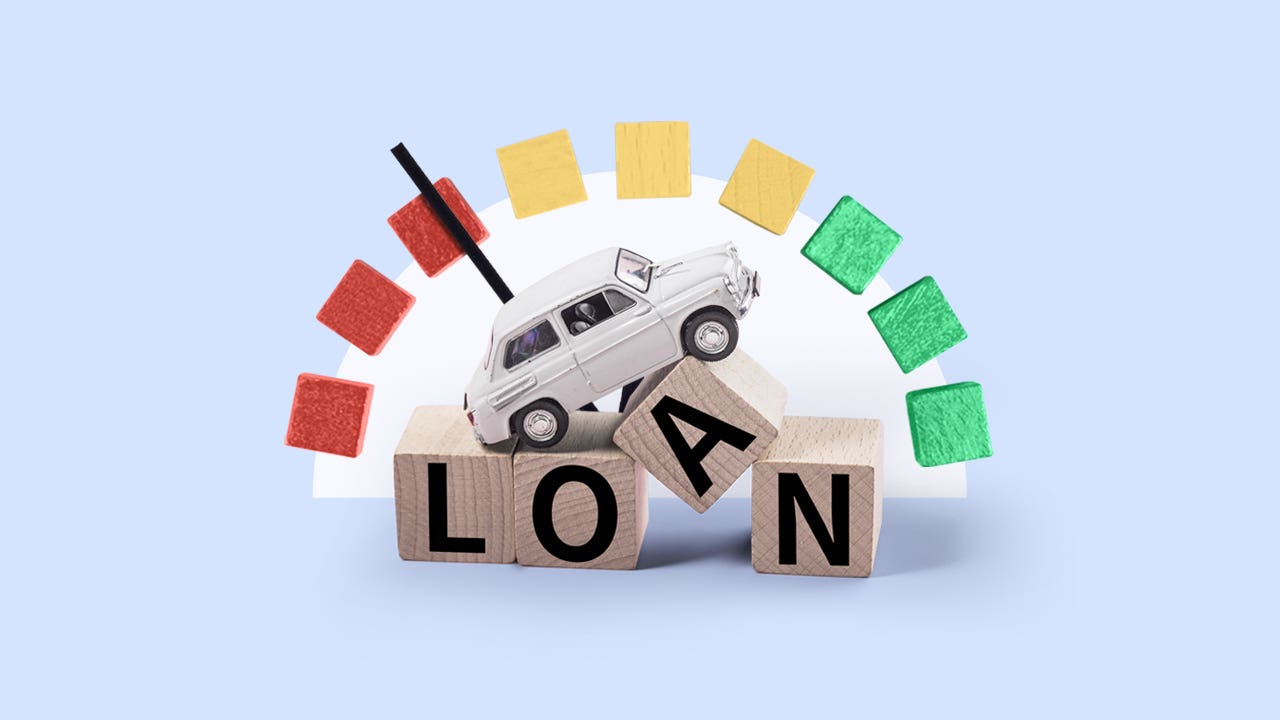How to get a car loan with bad credit: 10 tips for finding the best

The Bankrate promise
At Bankrate we strive to help you make smarter financial decisions. While we adhere to strict , this post may contain references to products from our partners. Here's an explanation for .
Key takeaways
- Bad credit loans are offered by banks, credit unions, online lenders and dealerships.
- Shop around to find the best deal on an auto loan for your budget and credit score.
- Try to improve your credit score before applying for an auto loan with bad credit.
Getting approved for a car loan from a traditional lender with a low credit score can be challenging. And while the average interest rate for a new car is 6.73 percent, borrowers with bad credit qualified for an average rate of 12.85 percent — or higher.
In addition, lenders are tightening lending requirements. That makes it even trickier for bad-credit borrowers to secure an auto loan, let alone get a good rate.
Although it will take more work to find a good loan, you don’t have to settle for a high-cost loan from a buy here, pay here dealer. With a little legwork, you can find the best bad-credit car loans for your financial situation.
Steps to getting a bad credit car loan
A lower credit score doesn’t mean you’re stuck with bad deals. By doing your homework and taking the proper steps, you can secure a budget-friendly car loan.
1. Know your credit score
Before you shop for financing, check your credit score. According to the FICO credit scoring system, which ranges from 300 to 850, any score below 580 is considered poor.
Your FICO score is calculated based on factors like how much you owe, the length of your credit history and your payment history. It can be lowered by things like:
- Not making your payments on time.
- Spending a high proportion of your available monthly credit.
- Having a short credit history.
By knowing your credit score, you can avoid applying for lenders that will reject you — and start searching for lenders that offer the best rates and work with people in your credit range.
Avoid opening new credit cards or loans before applying for an auto loan. Trying to repair your credit score before you apply will put you in a more favorable position with lenders.
2. Save for a down payment
Before you apply for a loan, know the monthly payment you can afford and what annual percentage rate (APR) you can expect for your credit score. Experts recommend a monthly payment of no more than 10 to 15 percent of your take-home pay.
Saving up for a down payment will help reduce your monthly payment. And, if you have a lower credit score, making a down payment on a car can increase your chances of being approved for an auto loan.
A down payment can offset higher interest rates and lower your loan-to-value ratio, which can also help you qualify for better terms. In general, a larger down payment is better when you have a low credit score. However, lenders may be willing to accept a down payment as low as $1,000.
Experts recommend a down payment of at least 20 percent, but if that’s too much, just put down what you can afford.
3. Research
Prepare as much as possible so you won’t be caught off guard when it comes time to negotiate the car price.
With a bad credit score, you will likely be offered some of the highest advertised rates. According to data from Experian, borrowers in the subprime category (a FICO score between 501 and 600) can expect an average rate of 12.85 percent for new cars and 18.97 percent for used cars.
| Credit score range | New car | Used car |
|---|---|---|
| Deep subprime: 300 to 500 | 15.62% | 21.57% |
| Subprime: 501 to 600 | 12.85% | 18.97% |
| Near prime: 601 to 660 | 9.62% | 13.72% |
| Prime: 661 to 780 | 6.89% | 9.04% |
| Super prime: 781 to 850 | 5.38% | 6.80% |
It also helps to know the Kelley Blue Book (KBB) value of your preferred car if you’re buying used or the MSRP set by the manufacturer if you’re buying new.
4. Shop around
Once you begin shopping, don’t limit yourself to just one lender. You can find bad credit auto loans by comparing multiple lenders.
- Banks and credit unions: If you already have a relationship with a bank or credit union, start here. Some will offer discounted rates and may be more willing to approve your loan if you have an established banking history.
- Online lenders: Many online lenders offer prequalification so you can see what terms you might be eligible for. Some lenders may also consider other details, like your employment history or education, when you apply.
- Car dealerships: You can finance through a dealership if you cannot secure a loan from another lender. However, dealerships often mark up the rates they offer to make more money. It may be easier to qualify — but your rates will likely be less competitive.
- Buy-here, pay-here dealerships: Buy-here, pay-here dealerships can be useful if you can’t find another option, but be cautious. While these dealerships may be more likely to approve someone with bad credit, the interest rates can be much higher.
5. Prequalify with multiple lenders
Prequalification lets you check your eligibility and loan terms before you apply. It can save time and avoid unnecessary hard credit checks that briefly lower your credit score.
Once you’re prequalified with a few lenders, compare rates to find the best deal. You can then submit documentation and get preapproved with your top picks. It’ll result in a hard credit check, but a preapproved auto loan holds more weight. It represents the lender’s commitment to extend an auto loan to you.
You’ll also have leverage in the dealership and can negotiate like a cash buyer.
All lenders will run a hard credit check during the application process. Prequalification allows you to preview your rate without this hard check, but as long as you keep applications to a 14-day period, your credit score won’t take multiple hits.
6. Shop loan terms, not monthly payments
Lower monthly payments look good on paper and are usually used to entice buyers. However, since they come with longer terms, they may lead to you paying more for your car over the life of the loan.
Remember, car loans for bad credit have higher interest rates and more fees. Double-digit rates and an extended term mean you may pay thousands more in interest than the car’s full value by the end of your loan term.
When shopping, look for the most favorable terms — usually the lowest APR over the shortest period. But make sure the monthly payment works for your budget. This is where prequalification and preapproval come in handy.
7. Consider a co-signer
Consider asking a trusted friend or family member to be a co-signer on your car loan. Ideally, this individual should have a steady source of income, a strong credit score and an exceptional credit history.
Co-signers reduce lenders’ risk because the co-signer is responsible for the loan if you can’t make payments. Because of this, a co-signer may result in a lower interest rate. However, the co-signer’s credit score can suffer if the loan becomes delinquent — even though they don’t own the vehicle.
8. Bring a friend to the lender
Ask a friend or a relative to go with you to the lender’s office, says Massachusetts-based consumer attorney Yvonne Rosmarin. Bringing someone you trust to the negotiating table can help inspire confidence. Confidence, combined with knowledge, can lead to more favorable loan terms.
9. Look out for add-ons
According to Josh Frank, former senior researcher for the Center for Responsible Lending, subprime buyers are more likely to encounter lending contracts with nonessential goods and services.
Never agree to a loan contingent on purchasing any add-on, such as extended warranties, after-market services or car insurance. Be aware of these add-ons, especially if you apply at a buy-here, pay-here dealership. In most cases, they are wrapped up in the loan — meaning you pay interest on services and products you may never use.
Rolling these costs into your loan means you may borrow more than the vehicle is worth, putting you at greater risk of being upside-down on your loan.
The FTC recently introduced the Combating Auto Retail Scams (CARS) rule to protect consumers and cut down on junk fees and bait-and-switch marketing. Slated to go into effect on July 30, 2024, it requires dealers to be more transparent and could lead to $3.4 billion in annual savings for drivers.
10. Be sure the terms are final
If you finance through a dealer, always confirm the terms are final before signing. A dealer may offer you conditional approval so you can drive off the lot, but be wary. Since the terms of your loan aren’t set, you may face higher monthly payments than you initially agreed to.
Some shady dealers will entice car buyers with low advertised rates but raise rates after the buyer signs a contract. This deceptive practice is called yo-yo financing. And while it may seem similar to conditional approval, the practice is illegal.
The bottom line
It may be tougher for you to get a car loan or lease a car with bad credit. You could also face less favorable terms or even predatory lending practices.
The good news is that research, saving up for a down payment and getting preapproved may help you get the best deal on an auto loan. Comparing lenders is the best way to check your rates and find the most competitive deal for your financial situation. You may also want to consider an alternative route, like postponing your purchase or using a personal loan to buy a car until your credit score improves.
If you find a car loan that’s right for you, make timely payments to help boost your credit score. After your credit score improves, consider refinancing with a different lender to secure better terms.
Related Articles


How to get a personal loan with bad credit & special considerations

